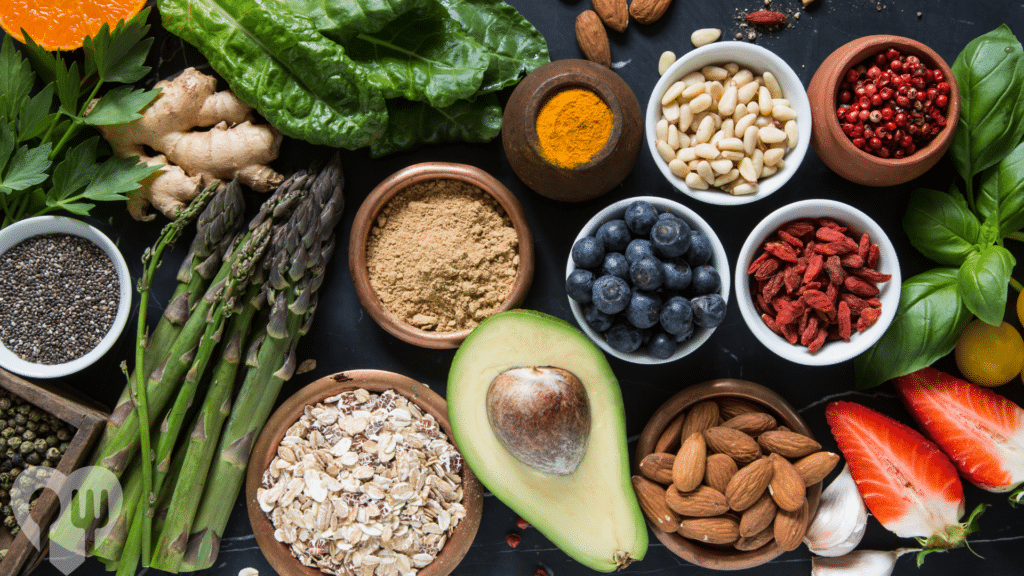Discover the Power of Healing Foods for Your Health
Healing Foods for a Healthy Life

Today, taking care of our health is more important than ever. Healing foods are a great way to do this. They are full of nutrients that help keep us healthy and even heal us. By adding these foods to our daily meals, we can feel better and live better.
This article will talk about different healing foods and their benefits. It will also show how to easily add them to a healthy diet. Eating the right foods is important for staying well and living a long life1.
Key Takeaways
- Healing foods support overall well-being and promote healing through their nutritional content.
- Adopting a nutritious diet rich in health-enhancing foods boosts energy and vitality.
- Plant-based nutrition offers a variety of healing foods that are beneficial for health.
- Incorporating nutrient-dense foods enhances your diet and supports long-term health.
- A holistic approach to wellness combines diet, lifestyle, and nutrition for optimal results.
The Benefits of Healing Foods
Healing foods are key to a balanced diet, offering many benefits for health. They are full of vitamins, minerals, and antioxidants. These nutrients help boost the immune system and prevent chronic diseases. Eating health-promoting foods daily can improve both physical and emotional health, making life better overall.
Nutritional Value and Impact on Health
Healing foods are packed with nutrients that support our bodies and reduce health risks. For example, omega-3 fatty acids in fish oil are good for heart health. The FDA says it’s safe to take up to 5 grams of fish oil daily2. But taking more than 3 grams a day might increase the risk of bleeding2.
High doses of omega-3 supplements can also weaken the immune system over time2.
Promoting Holistic Wellness through Diet
Wellness goes beyond just eating right; it includes our mental and emotional health too. Foods like oregano help with holistic wellness. Oregano fights inflammation and is full of antioxidants, making it great for any diet3.
Oregano also helps with digestion and stops harmful bacteria and fungi from growing3. Eating healing foods like oregano can greatly improve our health, showing how diet affects our overall wellness.
Understanding Nutrient-Dense Foods
Nutrient-dense foods are key to a healthy diet. They give you lots of nutrients for not many calories. Eating these foods helps you stay healthy and keep a good weight.
What Makes a Food Nutrient-Dense?
A food is nutrient-dense if it’s full of vitamins, minerals, and other nutrients for its calories. These foods also have fiber, antioxidants, and phytochemicals. The goal is to eat foods that are good for you but don’t have too many calories.
Examples of Nutrient-Dense Foods
Adding nutrient-dense foods to your meals can really boost your health. Here are some examples:
- Leafy greens like spinach and kale are packed with vitamins and minerals.
- Berries such as blueberries and strawberries are full of antioxidants and vitamins.
- Nuts and seeds give you healthy fats, protein, and important nutrients. For example, peanuts have about seven grams of protein per ounce, making them one of the top protein nuts. Almonds offer around six grams of protein and are loaded with Vitamin E and fiber4.
- Whole grains are full of fiber and nutrients, unlike refined grains.
By eating these nutrient-dense foods, you can make a diet that supports your health for a long time5.
Immune-Boosting Foods for a Stronger You
Eating foods that boost your immune system can be tasty and good for you. Adding immune-boosting foods to your meals helps your body fight off sickness. Foods like citrus fruits, garlic, ginger, yogurt, and some mushrooms are key for a strong immune response. They not only boost your immunity but also offer many health benefits.
Top Immune-Boosting Foods
- Citrus Fruits: These fruits are full of vitamin C, which is important for making white blood cells. These cells fight infections.
- Garlic: Garlic has antibacterial and antiviral properties. It helps make your immune system stronger.
- Ginger: Ginger reduces inflammation and helps with sore throats and other inflammatory diseases.
- Yogurt: Yogurt has probiotics that can boost your immune system and help your gut health.
- Mushrooms: Mushrooms like shiitake and maitake help your immune system and increase white blood cell production.
Incorporating Immune-Boosting Recipes into Your Diet
Adding immune-boosting recipes to your meals is easy and fun. Here are some ideas to start with:
- Citrus Salad: Mix oranges, grapefruits, and mint for a fresh side dish.
- Garlic Roasted Vegetables: Coat your favorite veggies with garlic and olive oil, then roast them.
- Ginger Tea: Make tea with fresh ginger and water, and sweeten it with honey.
- Greek Yogurt Parfait: Layer yogurt with berries and honey for a healthy breakfast.
- Mushroom Stir-Fry: Cook mushrooms with garlic and greens for a tasty dish.
These recipes are not only delicious but also good for your health. By eating these immune-boosting foods and recipes, you’re on your way to a healthier life. This change in diet can lead to more energy and a stronger immune system that fights off sickness6.
The Role of Superfoods in Healing
Superfoods are full of nutrients that help your health. They give you the vitamins and minerals you need. They also offer many benefits that can make you feel better overall. It’s important to know what makes superfoods special if you want to eat better.
What Are Superfoods?
Superfoods are foods full of antioxidants, fiber, and essential fatty acids. They are great because they have lots of nutrients but not too many calories. Eating these foods every day can make you healthier. It can boost your immune system and lower inflammation.
Popular Superfoods for Wellness
Some top superfoods are:
- Quinoa: A complete protein source, quinoa is rich in fiber and magnesium.
- Kale: Known for its high levels of vitamins A, K, and C, kale is a vital addition to any diet.
- Spirulina: This blue-green algae is noted for its high protein content and antioxidant properties.
- Acai Berries: Loaded with antioxidants, these berries can help combat oxidative stress.
- Matcha: A type of powdered green tea that provides a caffeine boost along with high antioxidant levels.
Eating superfoods for wellness can make you feel more energetic and clear-headed. It can also improve your overall health. Adding these foods to your meals helps you stay healthy and supports a complete approach to wellness.
Healing Foods for an Anti-Inflammatory Diet
Understanding how inflammation affects health is key to an anti-inflammatory diet. Chronic inflammation is linked to serious health problems like heart disease and arthritis. Eating anti-inflammatory foods can lower these risks and boost wellness. Omega-3 fatty acids from fish or fish oil are great for fighting inflammation, helping people with conditions like rheumatoid arthritis7.
The Link Between Inflammation and Health
Eating foods that fight inflammation is crucial. Fish oil supplements are full of omega-3 fatty acids, which can lower inflammation and help with blood pressure7. But, taking more than 4 grams a day can increase the risk of atrial fibrillation2. Turmeric’s compounds like curcumin also fight oxidative stress and inflammation well, especially with regular use over months7.
Key Anti-Inflammatory Foods to Include
Adding anti-inflammatory foods to your meals can greatly improve health. Here are some top foods to eat:
- Fatty fish like salmon and mackerel, rich in omega-3 fatty acids.
- Nuts and seeds, which provide healthy fats and are known for their anti-inflammatory properties.
- Berries, packed with antioxidants that combat oxidative stress.
- Oregano, notable for its anti-inflammatory compounds that can alleviate symptoms related to chronic conditions like arthritis3.
- Leafy greens such as spinach and kale, which offer vital nutrients that help reduce inflammation.
Health-conscious people can reduce their risk of chronic diseases by adding these foods to their daily meals. Adopting an anti-inflammatory diet is a proactive way to stay healthy and well.
Organic Healing Foods: Why They Matter
Organic healing foods are essential for staying healthy. Choosing organic offers many health benefits. These foods are full of nutrients that make you feel great.
The Importance of Choosing Organic
Organic foods don’t have synthetic pesticides or fertilizers. They’re made without GMOs too. This means you avoid harmful chemicals and live healthier.
Studies show organic foods have more vitamins and minerals. This makes your diet richer in nutrients. Organic farming also makes soil better, which means plants grow stronger and healthier8.
How Organic Ingredients Enhance Nutritional Value
Adding organic foods to your meals boosts your health. They taste better and smell great, making you want to eat healthier. Organic farming is good for the earth and for you.
More people are picking organic because it’s a smart health choice. Organic foods are better for your body, making them a great pick for anyone looking to get healthier5.
Culinary Techniques for Therapeutic Eating
Effective culinary techniques are key in therapeutic eating. Different cooking methods can greatly affect the nutritional value of our meals. Techniques like steaming, roasting, and raw preparation help keep nutrients in, making them vital for health-promoting dishes.
Cooking Methods that Preserve Nutrients
Using certain cooking methods keeps food’s nutrient levels high:
- Steaming – Keeps vitamins and minerals better than boiling.
- Roasting – Boosts flavors and keeps nutrients stable.
- Raw preparation – Gives unaltered enzymes and more nutrients.
- Sous-vide – Controls temperature precisely, preserving texture and nutrients.
Creating Health-Promoting Meals
Combining different cooking techniques makes meals tasty and healthy:
- Use a mix of vegetables and whole grains for more nutrition.
- Add herbs and spices for flavor without salt or sugar.
- Try meal prep methods for easy access to nutritious meals.
- Eat mindfully, enjoying each bite to support healthy eating habits.
These cooking methods and practices help with a holistic health approach through food. They focus on both physical and emotional health. By using these techniques, people can improve their diets and support therapeutic eating habits that meet their health goals91011.
Natural Remedies through Food
Food has always been key in keeping us healthy, acting as a powerful way to find natural remedies. More people now use food to help with health issues, thanks to its healing powers. This section shows how certain foods can help with common health problems and boost overall wellness.
Using Food as Medicine
Ginger, turmeric, and honey are great examples of foods that can be used as medicine. Ginger helps with nausea and has been used for centuries. Turmeric fights inflammation and can help with chronic inflammation. Honey is a sweetener and also helps with coughs, showing how food can have many health benefits.
Popular Natural Remedies to Enhance Health
- Ginger: Effective against nausea and can be used in teas or as a spice.
- Turmeric: Known for its ability to fight inflammation, great in curries or as a supplement.
- Honey: A natural cough suppressant, often added to herbal teas.
- Oregano: Full of antioxidants, it boosts immune health and fights bacteria3.
- Fish Oil: Gives omega-3 fatty acids, which can lower triglycerides and support heart health2.
More people now see these foods as ways to take care of their health. Adding these remedies to daily meals lets people take control of their health. It shows how food can be used as medicine.
Building a Nutritious Diet for Optimal Health
Creating a nutritious diet is key for good health. Meal planning helps add healing foods to your daily meals. It means picking foods full of nutrients that make you feel great and enjoy your food.
Strategies for Meal Planning
Good meal planning means thinking ahead for a healthy diet. Here are some steps to follow:
- Batch Cooking: Cook big meals ahead to save time. Soups, stews, and roasted veggies are great for this, and they can include healing foods.
- Varied Meal Plans: Plan meals for the week with lots of different foods. Make sure each meal has proteins, fibers, and vitamins.
- Use Seasonal Ingredients: Choose produce that’s in season for the best taste and nutrition. Foods like kale, sweet potatoes, and berries are great for your health.
Tips for Incorporating Healing Foods Daily
Adding healing foods to your meals every day can really improve your health. Here are some tips:
- Add Superfoods: Use superfoods like quinoa, chia seeds, and turmeric in your cooking. They’re packed with health benefits and fit into many dishes.
- Diverse Recipes: Try new recipes each week that highlight different healing foods. This makes meals fun and boosts your nutrient intake.
- Mindful Eating: Listen to your body’s hunger and fullness signals. This helps you eat healthier and focus on the quality of your food.
By using these strategies, you can make a diet that supports your health and makes you feel good. Planning meals with healing foods leads to eating better and feeling better.
Conclusion
Exploring healing foods shows how important they are for a healthy diet and overall wellness. By adding foods rich in nutrients and superfoods to our meals, we can boost our health and improve our lives.
Using organic ingredients and cooking methods that keep nutrients in can make healing foods even more effective. This approach helps us stay healthy and supports a better food system.
Adding healing foods to our meals is a key step towards a healthier life. It leads to lasting wellness and energy. This path to better health should be taken with care, seeing food as a way to heal and feed us1314.
FAQ
What are healing foods?
Healing foods support your health and help with healing. They are full of vitamins, minerals, and antioxidants. This makes them very beneficial for your health.
How can I incorporate healing foods into my diet?
Add healing foods like leafy greens, berries, nuts, and whole grains to your meals. Use recipes that boost your immune system. This makes eating these foods fun and tasty.
What are superfoods, and how do they impact health?
Superfoods are packed with nutrients and good compounds. Foods like quinoa, kale, and acai berries are great examples. They help improve your health and support wellness.
What role do organic ingredients play in healing foods?
Organic foods are often more nutritious and have fewer chemicals. Choosing organic helps your health and supports a sustainable diet.
How do anti-inflammatory foods help with health?
Foods like fatty fish, nuts, and berries reduce inflammation. This can lower the risk of heart disease and arthritis. Adding these foods to your diet can help keep you healthy.
Can cooking techniques affect the nutritional quality of foods?
Yes, how you cook food can change its nutritional value. Techniques like steaming, roasting, or eating foods raw help keep nutrients intact. This makes your meals more beneficial for your health.
What natural remedies can I find in healing foods?
Healing foods have many natural remedies. Ginger can ease nausea, turmeric fights inflammation, and honey helps with coughs. These foods are great for common health issues.
What strategies can I use for meal planning with healing foods?
Plan your meals by batch cooking and focusing on health foods. Make sure to include healing foods in every meal. This way, you always get the benefits of these foods.


